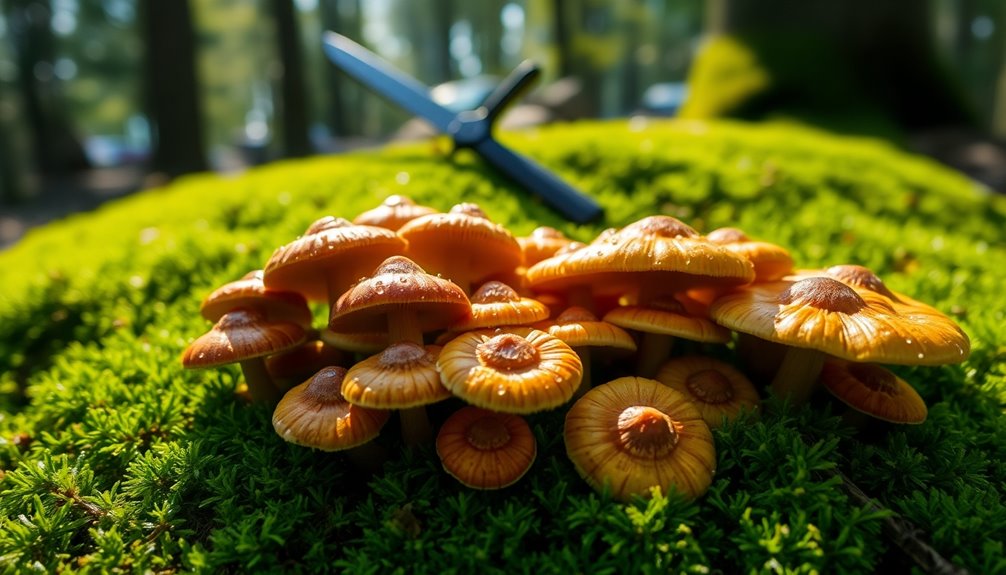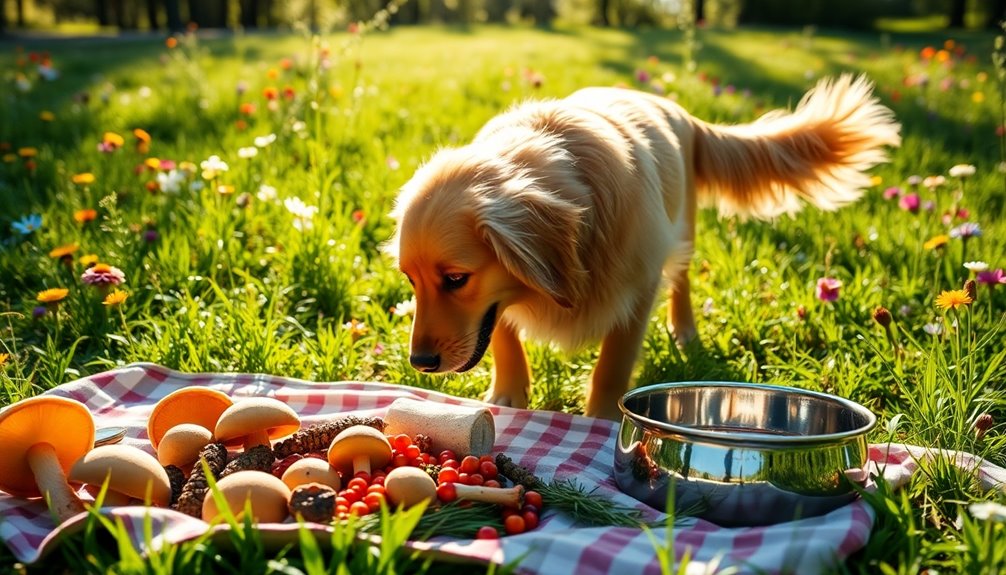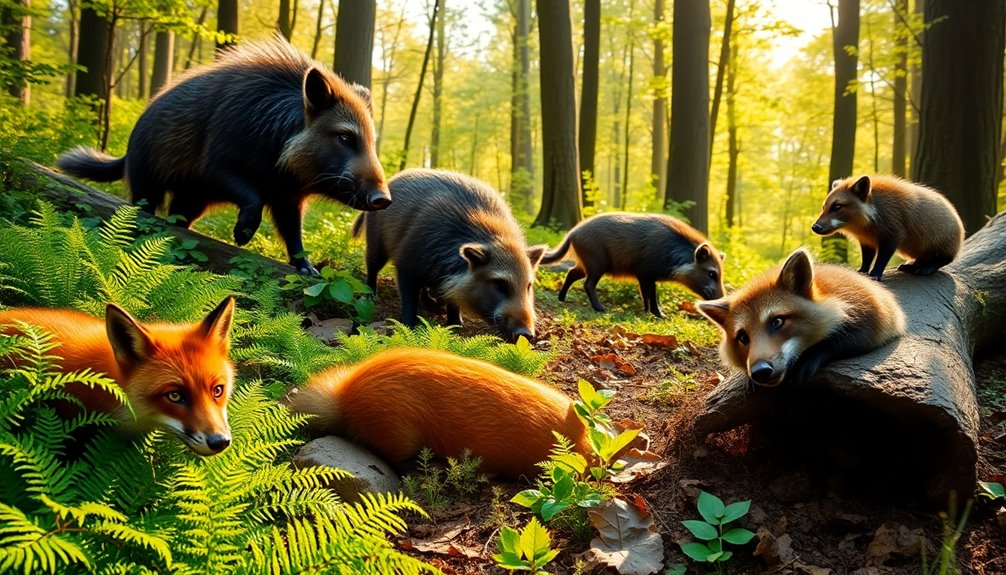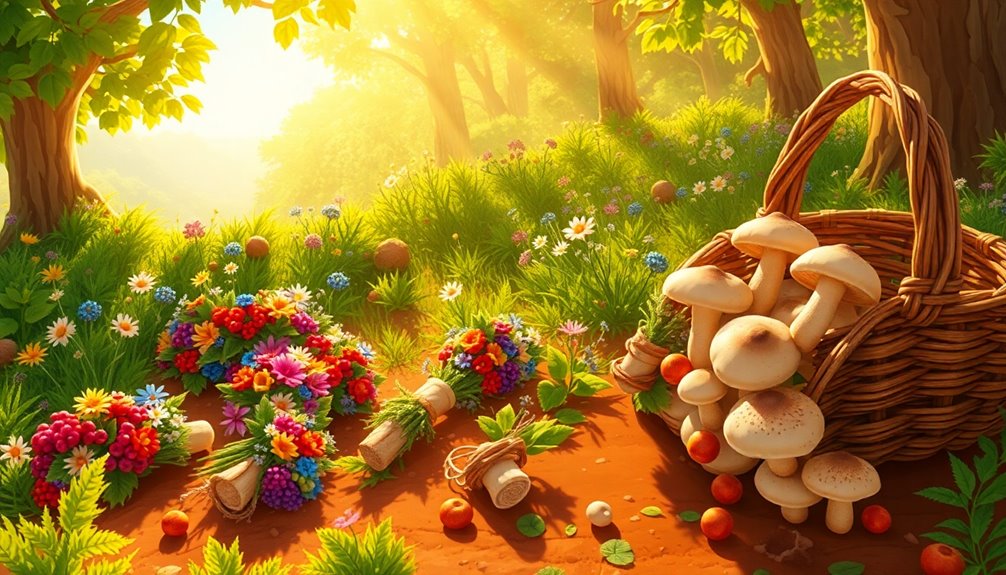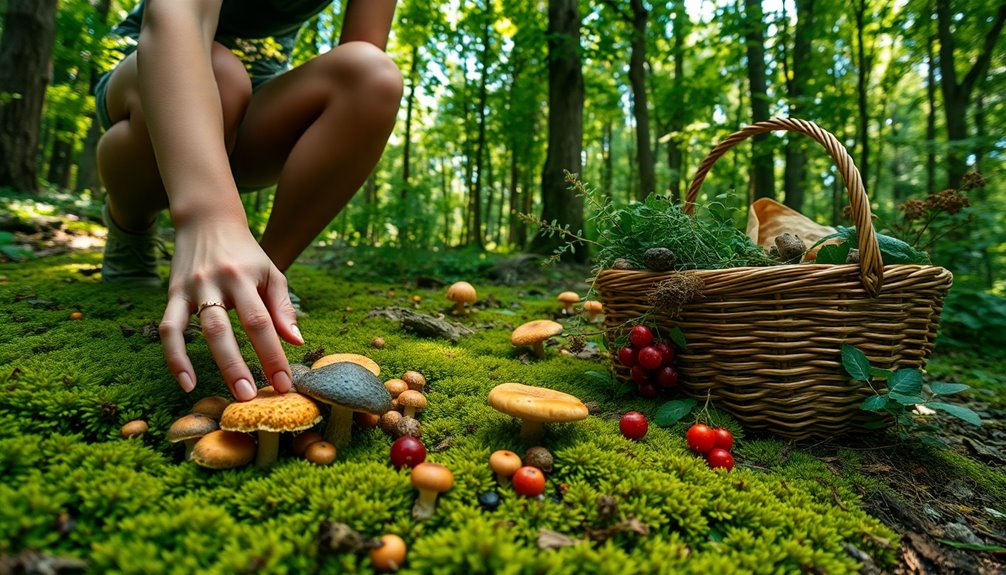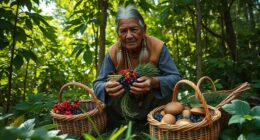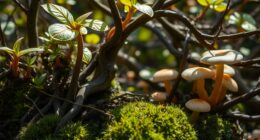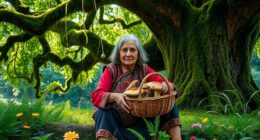Foraging for mushrooms can indeed be safe, but it comes with risks. Misidentifying mushrooms can lead to serious health issues, including poisoning from toxic varieties like the Death Cap. To enjoy the rewards of wild fungi, you need to learn how to accurately identify edible mushrooms and recognize their poisonous look-alikes. Using resources like field guides or consulting with experts helps guarantee what you forage is safe to eat. Always prioritize education and join local foraging groups for support. Stick with safe practices, and you'll discover the fascinating world of mushrooms. There's much more to explore about safe foraging techniques!
Key Takeaways
- Proper identification is essential, as many edible mushrooms have toxic look-alikes that can cause severe health risks.
- Misidentification leads to numerous emergency room visits annually, highlighting the importance of education and expertise in mushroom foraging.
- Responsible foraging practices are crucial to prevent biodiversity loss and protect local ecosystems, as fungi play a vital role in nutrient cycling.
- Thorough cooking is necessary for certain mushrooms to reduce toxicity risks, ensuring safer consumption and preparation methods.
- Joining local foraging groups and workshops enhances knowledge and skills, fostering safer and more sustainable foraging experiences.
Understanding Mushroom Types

When you're out foraging for mushrooms, how can you tell which ones are safe to eat? With around 10,000 mushroom species in North America, understanding mushroom types is vital for your safety.
While only about 250 of these are known to be poisonous, misidentification can lead to serious consequences.
Start with beginner-friendly options like the pearl oyster mushroom (Pleurotus ostreatus). This mushroom is easy to identify and has few harmful look-alikes.
However, always remember that even edible varieties can have toxic counterparts, emphasizing the need for careful observation and knowledge.
You might encounter medicinal mushrooms, such as lion's mane, which offer health benefits. Some species, like those containing psilocybin, are being researched for mental health treatments.
But tread lightly; the Death Cap mushroom (Amanita phalloides) is responsible for most mushroom-related deaths globally.
Before venturing into mushroom foraging, invest time in learning about various types and their characteristics.
Join local foraging groups, study field guides, and practice identifying mushrooms in their natural habitat.
With the right knowledge, you can enjoy the rewards of mushroom foraging while minimizing risks.
Risks of Poisonous Mushrooms
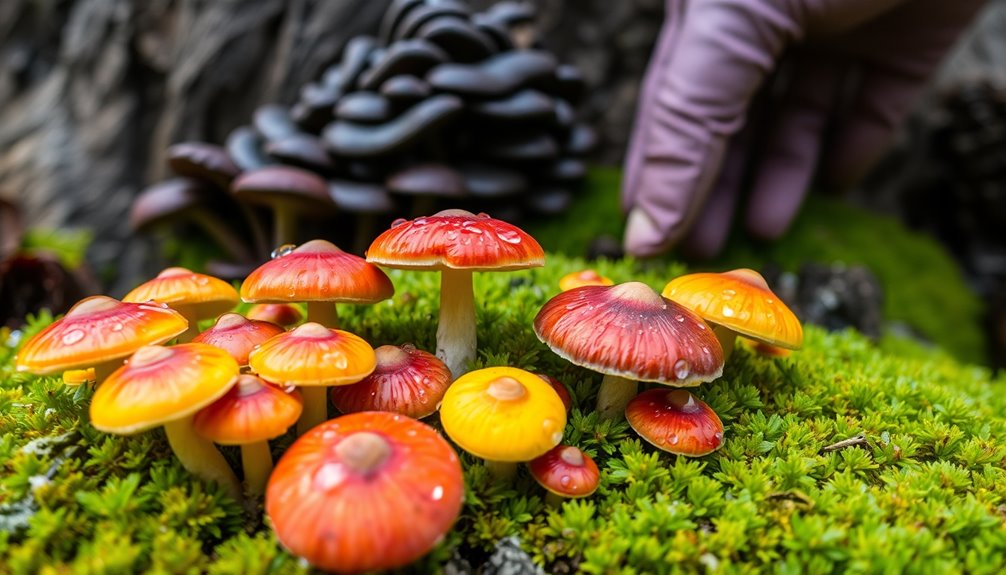
Foraging for mushrooms can be an exciting adventure, but it comes with considerable risks if you're not careful. North America boasts around 10,000 mushroom species, and approximately 250 of those are known to be poisonous. Misidentification is a primary cause of mushroom poisoning, which means you need to be vigilant. In 2016, the CDC reported 1,328 emergency room visits and 100 hospitalizations due to mushroom poisoning—proof that this isn't a trivial matter. Experts strongly advise that you only consume mushrooms that have been positively identified by professional mycologists. Just like driving, foraging involves risks, but your knowledge and experience can greatly reduce the likelihood of adverse reactions. Additionally, understanding seasonal growth patterns can enhance your foraging success and help distinguish safe varieties from dangerous ones.
Be mindful that certain mushroom species play a vital role in ecosystem health, making proper identification crucial for both safety and conservation. If you're unsure about a mushroom's identity, it's best to err on the side of caution.
Identifying Edible Varieties
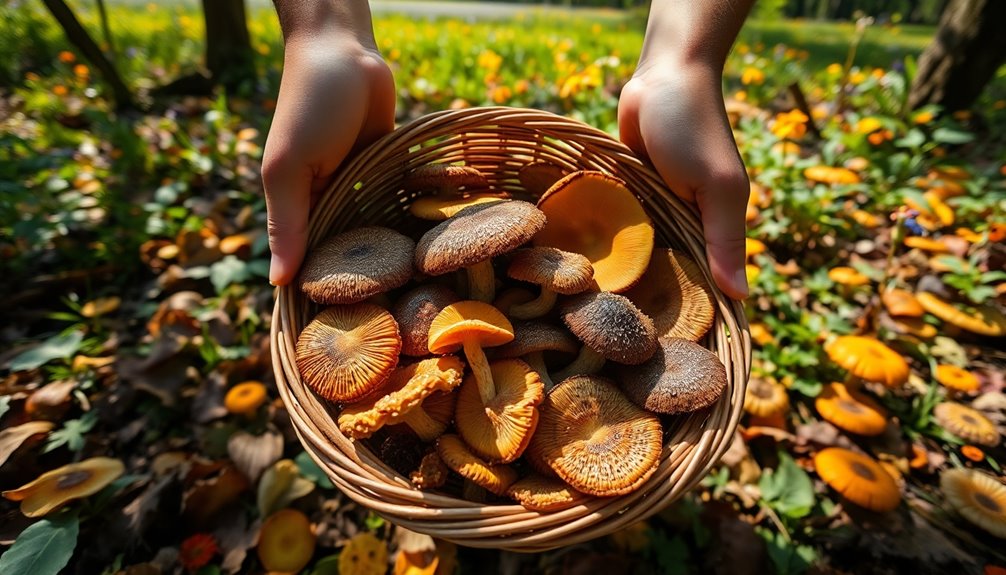
Identifying edible mushrooms is an essential skill for anyone enthusiastic to explore the world of foraging. To do this safely, you need to learn the specific characteristics of each variety, such as color, size, shape, and habitat. Resources like field guides and mycological societies can be incredibly helpful in this endeavor. For example, in regions like Minnesota's diverse ecosystems, foragers can find a variety of edible mushrooms alongside other wild edibles. Additionally, understanding the importance of high-quality protein sources can enhance your appreciation for the nutritional value of wild mushrooms. It's also beneficial to know that essential oils can be used to enhance the flavors of your foraged finds. Furthermore, consuming mushrooms can be a great way to incorporate antioxidants into your diet, as they are known to contain beneficial compounds.
As a beginner, start with easy-to-identify species, like pearl oyster mushrooms (Pleurotus ostreatus), which have minimal harmful look-alikes and are found in various habitats.
Always cross-reference multiple reliable sources, including field guides and apps, to confirm the identity of any edible mushrooms before consuming them. You might also consider participating in guided foraging tours led by experienced foragers. These tours offer hands-on learning opportunities that can enhance your identification skills in a safe environment.
It's vital to be aware of common toxic look-alikes, such as the poisonous death cap (Amanita phalloides). Misidentifying edible mushrooms can have serious consequences, so thorough knowledge and caution are key to enjoying the rewarding experience of foraging. Additionally, understanding the relationship between brain fog and Alzheimer's disease can help you stay mentally alert while foraging in the wild.
Symptoms of Mushroom Poisoning
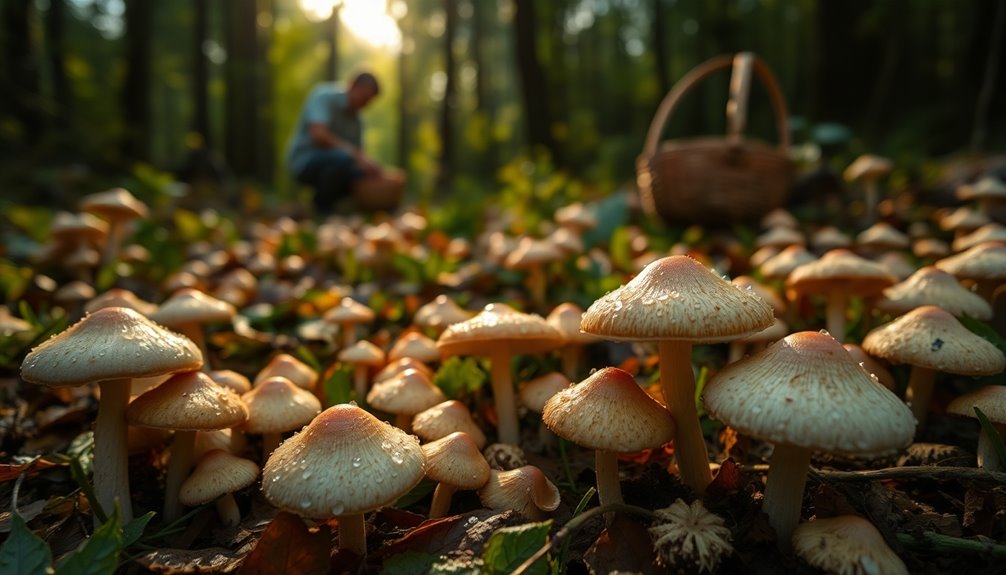
Mushroom poisoning can lead to a range of alarming symptoms that vary depending on the type of toxic mushroom consumed. If you've ingested a harmful variety, you might experience gastrointestinal distress shortly after, with symptoms like:
- Nausea
- Vomiting
- Diarrhea
- Abdominal pain
- Jaundice
In some cases, you may notice neurological symptoms, including confusion, dizziness, or even hallucinations. These effects can differ markedly based on the specific mushroom ingested.
If the poisoning is severe, it could result in critical damage to your liver and kidneys, which may manifest as dark urine or considerable abdominal pain.
Additionally, cardiovascular reactions like rapid or irregular heartbeat and low blood pressure could indicate mushroom poisoning, necessitating urgent medical attention.
Remember, the variability in symptoms means that even experienced foragers can face dangerous reactions. As a result, it's vital to exercise caution and guarantee accurate identification of mushrooms before consumption.
Understanding these symptoms not only helps in recognizing the potential dangers of mushroom poisoning but also reinforces the importance of safe foraging practices.
Immediate Response to Poisoning
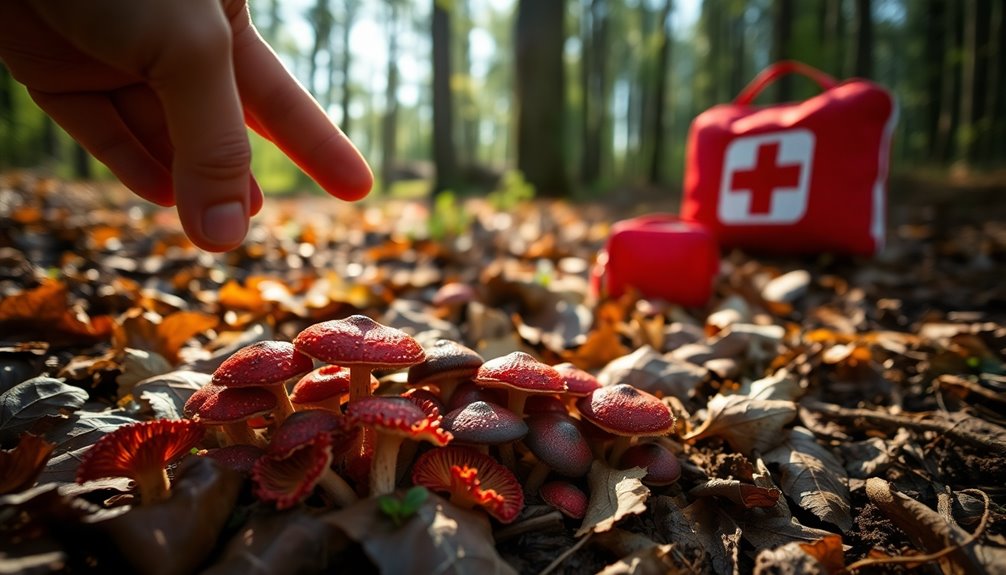
Experiencing symptoms of mushroom poisoning can be frightening, and knowing how to respond immediately can make all the difference. If you suspect mushroom poisoning, seek medical attention right away. This is essential to prevent severe health complications or even death.
Here's a quick reference table to guide your immediate actions:
| Step | Action | Notes |
|---|---|---|
| 1. Seek Help | Call emergency services | Don't wait; time is critical! |
| 2. Bring a Sample | Take the mushroom to the hospital | Helps with identification and treatment |
| 3. Do Not Induce Vomiting | Unless instructed by a professional | It may cause more harm |
| 4. Follow Medical Advice | Listen to healthcare professionals | They know best how to treat you |
| 5. Be Aware of Symptoms | Monitor for gastrointestinal or neurological issues | These require prompt evaluation |
Safe Foraging Practices
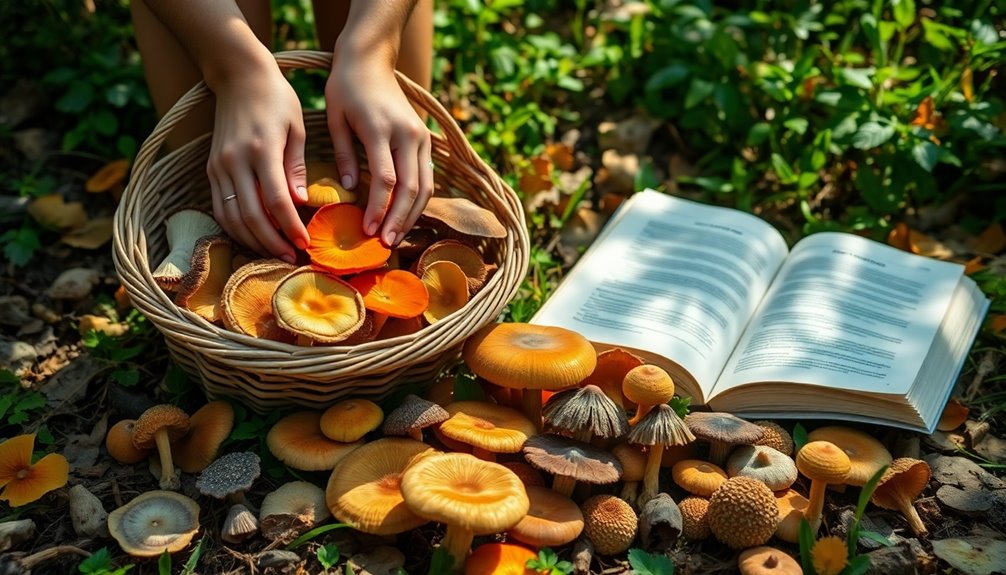
When you're foraging for mushrooms, education is key.
Familiarize yourself with local species and their toxic look-alikes, and consider joining a local foraging group for hands-on learning.
Always be cautious and avoid contaminated areas to guarantee a safe foraging experience.
Education on Identifying Mushrooms
To safely forage for mushrooms, you'll need to prioritize education and proper identification practices. Start by learning from experts and only consume mushrooms that have been positively identified by a mycologist or trained professional. It's also crucial to understand that individual responses to foraging experiences can vary based on age-appropriate books and personal knowledge. Engaging in activities like arts and crafts can enhance your observational skills, which are essential in mushroom identification. Additionally, using secure payment processing methods can help you manage any related expenses when purchasing foraging supplies or attending workshops.
In addition, utilizing tools such as watering pots can help you grow companion plants that attract beneficial insects, enhancing your foraging experience.
With around 250 out of 10,000 mushroom species in North America being poisonous, getting this right is essential.
Here are some key tips for identifying edible mushrooms:
- Use field guides and mobile apps to cross-reference your finds.
- Familiarize yourself with beginner-friendly mushrooms like pearl oyster mushrooms.
- Document the locations and conditions of found mushrooms for future reference.
- Join local mycological societies to gain practical experience.
- Attend workshops or foraging events to learn from seasoned foragers.
Additionally, consider the importance of safe sleep environments for your health and focus while foraging, as proper rest can enhance your attention to detail in identifying mushrooms.
Joining Local Foraging Groups
Joining local foraging groups can greatly enhance your mushroom foraging experience. These groups connect you with experienced foragers who can guide you on safe mushroom identification and harvesting techniques. This mentorship considerably reduces the risk of misidentification and potential poisoning. Additionally, understanding financial considerations for engaging in safe foraging practices can help you make informed decisions about participating in workshops and trips.
Many local foraging groups organize educational workshops and guided foraging trips, allowing you to learn about edible mushrooms and their toxic look-alikes in a supportive environment. Additionally, these workshops often incorporate foraging tips for rabbits, which can help expand your understanding of foraging as a holistic practice. Engaging in these educational experiences fosters personal growth as you learn to navigate the complexities of foraging safely. Furthermore, participating in foraging activities can improve your overall health, similar to how rapeseed honey offers numerous health benefits due to its rich nutrient content.
Engaging with local mycological societies fosters a sense of community among foragers. This shared knowledge enhances safety through collective experience, making it easier to identify what's safe to eat.
Participating in group foraging also helps you adhere to sustainable harvesting practices, ensuring local mushroom populations remain balanced. By prioritizing sustainability, you contribute to the health of ecosystems in your foraging areas.
Moreover, many foraging groups provide valuable resources on environmental considerations, such as selecting safe foraging locations. Additionally, understanding toxic look-alikes can significantly improve your ability to forage safely and avoid harmful species.
By joining these communities, you'll not only improve your foraging skills but also contribute to responsible foraging practices.
Avoiding Contaminated Areas
Choosing safe foraging spots is essential for mushroom hunters. To guarantee you're gathering clean and safe mushrooms, avoid areas that may be contaminated.
Here are some key considerations:
- Stay away from industrial sites and roadsides where pollutants may linger.
- Don't forage near agricultural fields due to potential chemical runoff.
- Research the historical use of the land; past activities can impact soil quality. For example, areas with a history of agricultural chemicals may pose additional risks. Additionally, Indigenous peoples often have extensive knowledge about traditional practices that can guide safe foraging choices.
- Inspect mushrooms carefully for contamination signs like unusual discoloration or strange odors.
- Educate yourself about local environmental pollutants and seek tested or known clean areas for foraging. Continuous monitoring of environmental risks can help ensure safe foraging practices.
- Additionally, consider the importance of community resilience when choosing foraging locations, as safe areas often have shared knowledge about local environmental conditions. Furthermore, understanding the nutritional benefits of various mushrooms can help you make informed choices about which species to pursue.
Cooking and Preparation Guidelines
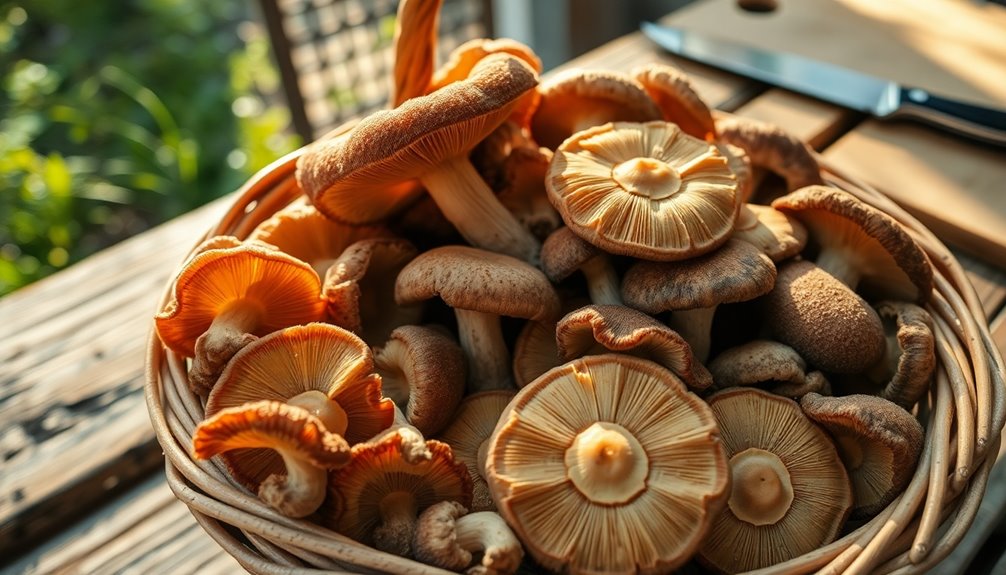
When it comes to cooking mushrooms, safety is your top priority.
You'll want to guarantee you identify edible varieties and avoid any toxic look-alikes. Proper cooking techniques not only enhance flavor but also reduce potential health risks.
Cooking Techniques for Safety
Cooking mushrooms thoroughly is vital for safety, as it reduces the risk of toxicity associated with certain varieties. For example, raw morels can lead to liver damage, so it's imperative to prepare them correctly.
Here are some effective cooking techniques to guarantee you're enjoying mushrooms safely:
- Sautéing: Cook mushrooms in oil or butter over medium heat until tender.
- Boiling: Boil mushrooms briefly to eliminate some toxins before further cooking.
- Grilling: Grill mushrooms to add flavor while making sure they're fully cooked.
- Baking: Bake mushrooms in the oven for an even cook and delightful texture.
- Dehydrating: Clean mushrooms with a soft bristle brush and dry them at high settings for 8-12 hours for long-term preservation.
Identifying Edible Varieties
Identifying edible mushroom varieties requires careful attention to detail and knowledge of their characteristics. Start by consulting multiple reliable sources, like field guides or experienced foragers, to guarantee you're accurately identifying edible species. Remember, about 250 of the 10,000 mushroom species in North America are poisonous, so diligence is vital.
A great beginner-friendly option is the pearl oyster mushroom (Pleurotus ostreatus), known for its easy identification and minimal harmful look-alikes. Always pay close attention to distinguishing features, such as color, size, and habitat.
Once you've identified edible varieties, proper cooking is essential. For example, morels must be thoroughly cooked to avoid potential liver damage from raw consumption.
When preparing your foraged mushrooms, clean them gently with a soft bristle brush to remove any debris, avoiding water that can alter their texture and flavor.
If you want to preserve your mushrooms, consider dehydrating them. For oyster mushrooms, the recommended drying time is 8-12 hours in a dehydrator at high settings. This enhances their shelf life and flavor, guaranteeing you enjoy the fruits of your foraging efforts safely. Additionally, it's important to maintain a clean and safe environment to prevent any contamination during the foraging process.
Avoiding Toxic Look-Alikes
Properly identifying mushrooms is just the first step in foraging; avoiding toxic look-alikes is equally important. Many edible mushrooms have dangerous counterparts, like the Death Cap, which can be confused with the Paddy Straw mushroom.
To stay safe, follow these guidelines:
- Always consult multiple identification resources, such as field guides and mobile apps.
- Focus on beginner-friendly species like the Pearl Oyster mushroom, which has few harmful look-alikes.
- Avoid consuming any wild mushrooms unless they've been identified by a professional mycologist.
- Cook mushrooms thoroughly, as this can reduce toxicity; raw morels can cause gastrointestinal distress, but cooking them helps eliminate harmful compounds.
- Keep an eye out for common toxic look-alikes, and learn their distinguishing features.
Environmental Impact of Foraging

Foraging for mushrooms can considerably impact local ecosystems, particularly when it disrupts the food sources of native mammals. In Australia alone, around 40 species depend on fungi as part of their diet, making responsible foraging practices important. When you gather edible species without consideration, you risk destabilizing the delicate balance of these habitats.
Here's a glimpse into the consequences of irresponsible foraging:
| Impact | Description |
|---|---|
| Disruption of Food Sources | Native mammals lose critical nutrients, leading to decline. |
| Biodiversity Loss | Overharvesting can reduce fungal diversity, harming ecosystems. |
| Altered Nutrient Cycling | Fungi's role in breaking down organic matter diminishes. |
Fungi not only recycle nutrients but also form significant relationships with trees, enhancing nutrient exchange. To minimize the environmental impact of foraging, it is important to engage in responsible practices and promote awareness of fungi's ecological importance. By documenting local fungal diversity, you help foster a sustainable relationship with wild fungi, ensuring these ecosystems remain healthy for generations to come.
Importance of Education and Training
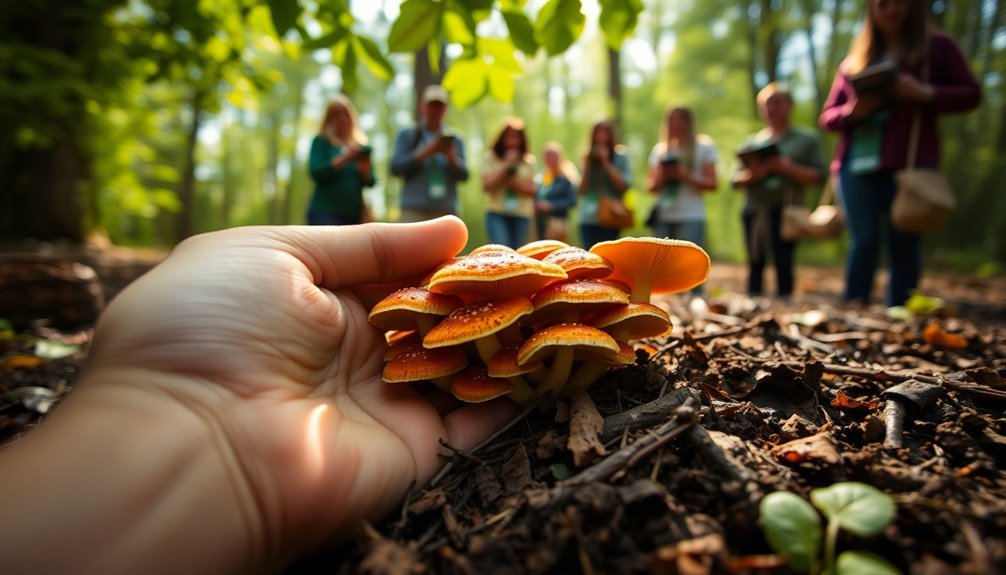
Understanding the ecological consequences of foraging highlights the need for education and training in mushroom identification. With around 10,000 species of mushrooms in North America and about 250 of them being poisonous, it's crucial for you to be well-informed before venturing out to forage.
Experts strongly recommend consuming only those mushrooms identified by trained professionals to avoid health risks from misidentification.
Here are some key reasons why education is important:
- Comprehensive knowledge: Learn to distinguish between edible and toxic species.
- Community programs: Participate in local education initiatives that promote safe foraging practices.
- Engaging courses: Enroll in mycological workshops to gain hands-on experience.
- Supportive networks: Join local foraging groups where you can connect with experienced foragers.
- Reduce health risks: Stay informed to minimize the dangers of toxic mushrooms, which caused 1,328 ER visits in 2016.
Investing in your education about mushrooms not only enhances your foraging experience but also guarantees that you can safely enjoy the rewards of wild fungi without the risks.
Advocacy for Mushroom Safety
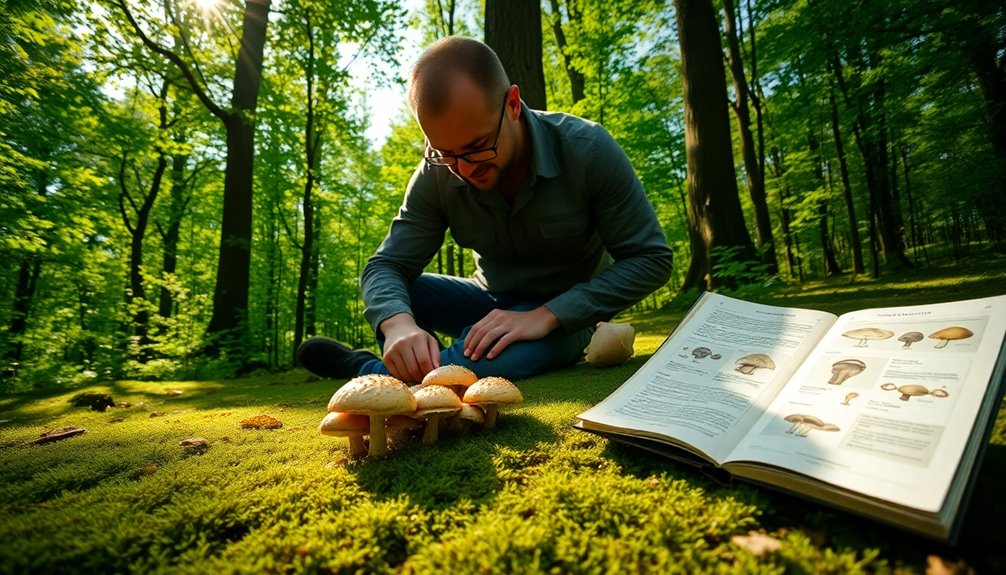
Advocating for mushroom safety is essential in today's foraging landscape, where misinformation can lead to dangerous consequences. Collaborating with health departments, like the Montana Department of Health and Human Services, helps enhance public awareness about safe mushroom consumption and identification.
You can access an information sheet specifically about morels online, which provides critical safety guidelines and emphasizes sharing personal experiences to prevent future mushroom poisoning incidents.
Efforts to improve mushroom safety also include advocating for better labeling on commercially-sold morels. Clear cooking guidelines will educate consumers about safe practices, reducing the risk of mishaps.
Ongoing research into the safety of wild mushrooms, especially true morels, highlights the necessity of understanding potential risks associated with foraging and consumption.
Engaging with the community through educational initiatives fosters a culture of safe foraging practices. By participating in these efforts, you can contribute to preventing mushroom-related illnesses.
Frequently Asked Questions
Is It Safe to Forage for Mushrooms?
When you're considering foraging for mushrooms, safety's a big concern.
It's essential to know that while many mushrooms are edible, others can be toxic. You should only pick mushrooms you can positively identify, ideally with the help of an expert.
Starting with easily recognizable varieties, like pearl oyster mushrooms, can build your confidence.
Is It Safe to Eat Mushrooms From the Woods?
Eating mushrooms from the woods can be risky if you're not careful.
You should only consume those you can positively identify as safe and edible. Misidentifying mushrooms can lead to serious health issues, so it's essential to learn from experts or use reliable resources.
Start with easily recognizable varieties, and always err on the side of caution. If you're unsure about a mushroom, it's best to leave it alone.
What Is the Risk of Wild Mushrooms?
When you're foraging for wild mushrooms, the risk lies primarily in misidentification.
Out of the roughly 10,000 species in North America, many can be toxic. If you don't have proper knowledge, you could mistake a poisonous mushroom for an edible one. This can lead to serious health issues, including emergency room visits.
It's essential to learn from experts and be cautious, ensuring you only eat mushrooms you can confidently identify.
How to Tell if a Wild Mushroom Is Safe to Eat?
Determining if a wild mushroom is safe to eat can feel like solving a life-or-death mystery!
You've got to rely on expert identification; even one wrong guess can lead to disaster. Familiarize yourself with edible varieties and their toxic look-alikes. Use trusted guides and apps for double-checking.
Always cook mushrooms properly, as some can be risky raw. Joining local foraging groups can also boost your skills and confidence in this thrilling adventure!
Conclusion
In the world of mushroom foraging, knowledge is your best friend. Remember, "all that glitters isn't gold." While the thrill of discovering wild fungi can be rewarding, it's crucial to tread carefully. Educate yourself on identifying edible varieties and be mindful of the risks. With the right training and respect for nature, you can safely enjoy the bounty it offers. So, grab your basket, but keep your wits about you—safety should always come first!

